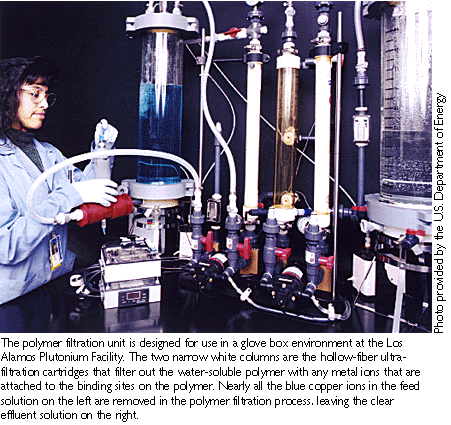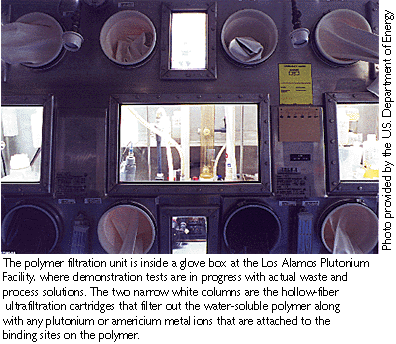
on the efficient separations
and processing crosscutting programAbout the focus areas
The U.S. Department
of Energy’s Office of Environmental Management
has established an integrated approach for addressing
waste issues based on problem, or focus areas. The focus
areas are subsurface contaminants; mixed waste
characterization, treatment, and disposal; radioactive
tank waste remediation; decontamination and
decommissioning; and plutonium stabilization. Three
crosscutting technology areas support the focus areas:
characterization, monitoring, and sensor technology;
efficient separations and processing; and robotics.
Since its establishment in 1991, the efficient
separations and processing crosscutting program has
identified, developed, and tailored separations
technologies and processes to address high-priority waste
remediation problems involving high-level, low-level,
transuranic, hazardous, and mixed waste. Separation
methods concentrate contaminants, purify waste streams
for release to the environment, or downgrade the waste to
a form that is easier and less expensive to dispose of.
Many dollars can be saved if new separations technologies
and processes produce even a marginal reduction in cost.
Mission
ESP-CP’s mission is to address the
separations and processing needs of the focus areas by
providing separations technologies to recycle chemicals,
minimize process wastes, and, if possible, recover
economic values. The technologies provided improve
performance, safety, environmental protection, and
economics as compared to baseline technologies. ESP-CP
also is instrumental in transferring separations
technologies to the U.S. industrial sector.
To achieve its mission, ESP-CP provides separations
and processing technologies that work in the following
ways:
- remove dilute radionuclides and toxic materials
from aqueous and solid phases,
- condition and treat wastes to enhance separations
(e.g., calcination, leaching, or dissolving
sludges),
- remove bulk constituents from waste streams to
recover chemicals for recycle and waste
minimization,
- separate solids from liquids, and
- destroy complexants and bulk anions.

Current
work
For fiscal year 1997, ESP-CP is funding 31
multiyear tasks that fall into three main categories:
separations processes, chemical reactions, and process
development. More than half these tasks include
university staff and outside collaboration. Descriptions
of each task are available on ESP-CP’s home page at http://www.pnl.gov/
eff_sep/index.html.
ESP-CP
success
An estimated $750 million cost savings to
EM can be attributed to a cumulative $75 million
investment in ESP-CP, based on its four most mature tasks
alone (see first four bullets below)—a 10:1
benefit-to-cost ratio for the program. Additional cost
savings are expected as other tasks are brought to
fruition.
ESP-CP has received high marks from organizations such
as the National Academy of
Sciences, the National
Research Council, and the Strategic Laboratory
Council. The program has the best Small Business and
Innovative Research performance in EM-50 and has
received wide praise for its technical exchange meeting
and proposal and project peer review process.
Program
management
 In August
1996, the Oak Ridge
Operations Office was designated the field lead
implementation center for ESP-CP and, as such, has
responsibility for providing technical expertise,
information gathering and dissemination, and linkage to
end users. Involvement of ORO as field implementation
center is being blended with the existing ESP-CP
structure of a DOE-HQ program manager supported by field
coordinators at Richland, Savannah River, and Oak Ridge. In August
1996, the Oak Ridge
Operations Office was designated the field lead
implementation center for ESP-CP and, as such, has
responsibility for providing technical expertise,
information gathering and dissemination, and linkage to
end users. Involvement of ORO as field implementation
center is being blended with the existing ESP-CP
structure of a DOE-HQ program manager supported by field
coordinators at Richland, Savannah River, and Oak Ridge.
Deploying
ESP-CP technologies
ESP-CP has sponsored the following
technologies that are now being used or considered for
use at DOE sites. (The names in parentheses are the
principal investigators on these projects.)
- Volume reduction by plutonium distillation (Ed
Garcia, Los Alamos National Laboratory) was
selected by the Office of Nuclear Material and
Facility Stabilization (EM-60) for use at Rocky
Flats.
- Crystalline silicotitanates sorbent (Norm Brown,
Sandia National Laboratories) was selected by Oak
Ridge for cesium demonstration. This technology
also won an R&D 100 Award.
- Electrochemical destruction of nitrate/nitrite
and caustic recycle (David Hobbs, Savannah River
Technology Center) is a serious option for the
Office of Waste Management (EM-30) at the
Savannah River Site.
- Water-soluble chelating polymer filtration
(Gordon Jarvinen, Los
Alamos National Laboratory) is being
considered for treating LANL’s acid
plutonium waste. Additional projects at LANL are
evaluating the potential of the technology for
industrial applications. In 1995, the LANL
project team and collaborators at Boeing
Aerospace received an R&D 100 Award for the
application of polymer filtration to recycle
metals from electroplating operations. Micro-Set,
Inc. has licensed the technology for
electroplating and some related areas. While
application of polymer filtration to
electroplating operations is nearest to
commercial deployment, the prototype equipment
developed for these markets is expected to be
readily transferable to operations at DOE
wastewater treatment facilities or in glove boxes
at LANL’s Plutonium Facility.
- Sodium nonatitanate is being considered for
in-tank strontium removal at SRS.
- The extended TRUEX process (Phil Horwitz, Argonne National
Laboratory) is a leading option for
high-level waste processing at Idaho National
Engineering and Environmental Laboratory.
- Hanford stakeholders have continuing interest in
the ESP-CP- developed "clean salt"
process for selectively removing sodium nitrate
from Hanford Site tank waste by a large-scale
fractional crystallization process (Dan Herting,
Numatec).
- Improved environmental sampling in the field
(Jane Bibler, Savannah River Technology Center)
helps determine radionuclide concentrations in
seawater.
- Ligand modeling results (Ben Hay, Pacific Northwest
National Laboratory) are being used at ANL
for solvent extraction design.
Because of sharply declining budgets, ESP-CP will not
solicit any new work in FY98 or beyond. ESP-CP
appreciates the past interest in the program shown by
scientists and engineers and regrets that it will be
unable to sponsor further valuable work on separations
and processing.
For more information about ESP-CP, see its home page
at http://www.pnl.gov/eff_sep/index.html.
Correction
In the February spotlight on the D&D
focus area, Argonne National Laboratory should also have
been included as one of the members of the Strategic
Alliance, the Integrated Contracting Team for the CP-5
large-scale demonstration project.
|


